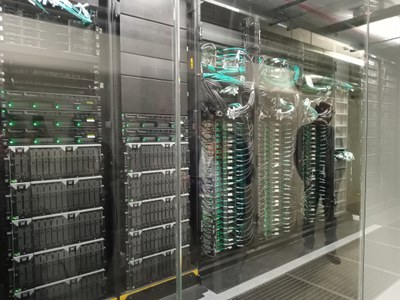ICT
|
Image credits: Valentina Giannini |
Key messages
-
Both acute (i.e. extreme weather events) and chronic climate effects (i.e. longer-term changes in the environment) are affecting information and communications technology (ICT).
-
ICTs are being increasingly recognized as enablers of innovative approaches to mitigate, monitor and adapt to climate change impacts.
-
The EU adaptation strategy clearly states that the digital transformation is critical to achieving the Green Deal adaptation objectives. New instruments such as Destination Earth and Digital Twins hold great promise to boost our understanding of present and future climate impacts at planetary and local scale. Ocean measurements and observation will be also be further strengthened.
Impacts and vulnerabilities
The challenges posed by climate change for the ICT fall into two main categories: acute events and chronic stresses. Acute events (also termed critical or crisis events) include floods (pluvial, fluvial, coastal), hurricanes, ice storms, heatwaves, etc. Acute events compromise ICT infrastructures by destroying or disabling the physical assets that they depend on. While they may have devastating effects, acute events tend to be short-lived.
Chronic stresses result from more gradual changes in climate norms. These changes include increased diurnal and annual temperature ranges, greater exposure to temperature extremes, longer sustained high temperatures, more rapid temperature variation, higher humidity and second order effects such as changes in patterns of precipitation and wind leading to more frequent water ingress or storm damage. While these impacts are less likely to have catastrophic consequences, they will lead to increased asset degradation, more frequent failures and shorter life spans which in turn will have significant financial consequences because assets will need more frequent upgrade and replacement cycles and probably require more intense monitoring for signs of deterioration. Chronic stresses manifest themselves over much longer timeframes. Further a warming and more variable climate stresses the electricity grid by increasing cooling demand requirements.
Further data centers use significant amounts of water on-site primarily for their cooling system, which is comprised of cooling towers, chillers, pumps, piping, heat exchangers / condensers, and computer room air conditioner (CRAC) or computer room air handler (CRAH) units.
These two types of stress are not discrete: a third type of stress has been identified as a “chronic crisis” or “chronic hazard condition”, essentially an acute event sustained for a significant period of time (e.g. flooding that lasts for weeks or months instead of days – such as that experienced in 2012).
However ICT is naturally decentralized and modular, and therefore has a high climate resilience. Redundant landlines, Internet service provider diversity, emergency roaming and cell phone micro-charging backup systems will increase ICT climate resilience. This might change in the future with increased cloud computing, in which there are concentrations of infrastructure. Likewise, the majority of all transatlantic internet traffic passes via the Netherlands, where a few connectors link both continents.
Policy framework
Overall, the policy framework for climate adaptation for information and communications technology (ICT) in the EU is focused on improving the resilience of ICT infrastructure to climate change impacts and reducing the environmental footprint of the sector through energy efficiency measures and other initiatives. The policy framework for climate adaptation for ICT in the EU is established through the EU Digital Agenda. In 2020, the second five-year digital strategy – shaping Europe’s digital future – focused on three key objectives in digital transformation: technology that works for people, a fair and competitive economy and an open, democratic and sustainable society. In 2021, the strategy was complemented by the 10-year digital compass: the European way for the digital decade, which puts the EUʼs digital ambitions for 2030 into concrete terms. In there the ICT sector plays a major role in combating climate change and its effects. The EU adaptation strategy clearly states that the digital transformation is critical to achieving the Green Deal adaptation objectives. New instruments such as Destination Earth and Digital Twins hold great promise to boost our understanding of present and future climate impacts at planetary and local scale. Ocean measurements and observation will be also be further strengthened.
Supporting investment and funding
The EU has also launched several funding programs to support climate adaptation for ICT. For example, the European Regional Development Fund provides funding for projects that improve the resilience of ICT infrastructure to climate change impacts. The Horizon Europe research and innovation program also supports research and innovation in the field of climate adaptation for ICT.
A comprehensive overview can be found on the EU funding of adaptation measures page.
Supporting the implementation of adaptation
As part of an EC mandate started in 2014, the Commission and CEN-CENELEC have sought to address the adaptation of European standards and standardization to climate change, with special emphasis on the resilience of key sectors. This has led to revising infrastructure standards in the sectors impacted by climate change such as energy, transport, construction and ICT.

